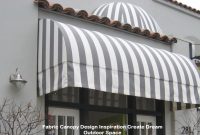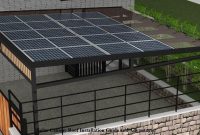The use of tempered glass canopies is increasingly popular in modern homes. This material adds an elegant and functional touch and enhances the character of a home’s facade. The glass’s transparency allows natural light to enter, making carports, terraces, or balconies feel brighter without creating excessive heat.
Tempered glass is also known for its high toughness. According to industry data, tempered glass has an impact resistance approximately 5–7 times stronger than regular glass, making it safe for use as an exterior home element, such as canopies. This characteristic allows it to withstand rain, wind, and extreme temperature changes.

Advantages of Tempered Glass Canopies
Tempered glass canopies offer weather protection without compromising the building’s aesthetics. The material is resistant to warping, rusting, or dulling. If broken, the glass breaks into small, non-sharp granules, making it safer to use.
Visually, the appearance is clean, luxurious, and modern. Natural lighting can reduce the need for lamps during the day and create a more spacious atmosphere. Maintenance is also simple; simply clean the glass regularly with water and liquid soap to maintain its clarity.
The YouTube account @marchitectpurwokerto reviews the advantages of tempered glass canopies with rust-resistant and strong 304-grade stainless steel frames. The Spider Fitting system allows the glass to stand elegantly on the frame without obscuring the structure, providing a luxurious and modern look. The tempered glass used is safety glass, which is shatterproof and remains safe in the event of an impact. This canopy also provides maximum lighting without creating noise during rain, making it suitable for luxury homes and modern buildings.
Design Recommendations
Below are six design inspirations that you can adapt to the character of a modern home:
1. Minimalist Glass Canopy Design
This tempered glass canopy model emphasizes straight lines and sleek structural elements. It is suitable for homes with minimalist, industrial, and contemporary concepts. The visual impression is clean and not overdone.
2. Curved Glass Canopy Design
The curved shape creates a dynamic and futuristic impression on the home’s facade. Besides being visually appealing, this shape also helps drain rainwater more quickly and prevents pooling on the glass surface.
3. Sandblasted Glass Canopy Design
The frosted effect on the glass provides privacy without blocking natural light. Perfect for back patios, balconies, or outdoor relaxation areas that require light but not too much exposure.
4. Glass Canopy Design with Stainless Steel Frame
The use of a stainless steel frame gives the canopy a modern and premium look. This material is rust-resistant and highly durable, making it suitable for exterior areas frequently exposed to rain and humidity.
5. Modular Glass Canopy Design
The modular concept makes it easy to arrange glass panels as needed. This design is flexible for elongated areas such as two-car carports or modern residential corridors with wider roof spans.
6. Frameless Glass Canopy Design
The frameless model emphasizes a fully transparent appearance. With virtually no joints, it looks luxurious, neat, and blends harmoniously with modern building architecture.
Comparison Tempered Glass Canopy vs. Clear Glass Canopy
Tempered glass and clear glass have fundamental differences in strength, safety, and use. Tempered glass is much stronger, typically 3 to 5 times stronger than regular clear glass, and is able to withstand impacts and extreme temperature changes. When broken, tempered glass shatters into small, non-sharp shards, making it safer and more suitable for applications such as gazebo roofs, canopies, and glass doors.
Clear glass, on the other hand, offers perfect clarity, providing a clear, natural view without visual distortion, perfect for a minimalist aesthetic and maximum transparency. However, this glass is more fragile and can shatter into large, dangerous shards, making it less suitable for areas prone to impact or extreme temperatures.
In general, tempered glass is better suited for applications that require strength and safety, such as gazebo roofs and outdoor canopies, while clear glass is ideal for aesthetic and interior applications that are less susceptible to impact.
Choosing a tempered glass canopy provides both aesthetic value and long-term protection for your home. For outdoor areas, a thickness of 8–12 mm is ideal for maintaining a sturdy and secure structure. With the right design, a glass canopy can become an architectural accent that enhances the character of a home’s facade while adding comfort to the space. /nrm



